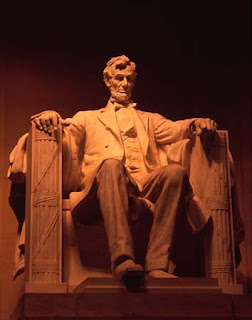Sunday, July 01, 2007
Portable Torture Kit
Bob Thompson, Imperial Washington: The Author of 'Are We Rome?' Takes In the Sights And Similarities, Washington Post (June 30, 2007), on Cullen Murphy:
 On the reverse of the following Roman coin from 83 B.C. you can see the fasces in the middle, with the axe head protruding to the left halfway up:
On the reverse of the following Roman coin from 83 B.C. you can see the fasces in the middle, with the axe head protruding to the left halfway up: The Mercury dime (minted in the United States from 1916 to 1945) also had the fasces on the reverse, with the axe head at top left:
The Mercury dime (minted in the United States from 1916 to 1945) also had the fasces on the reverse, with the axe head at top left:
 The Mercury dime was replaced in 1946 by the Roosevelt dime, which had the more peaceful olive branch on the reverse (to the left of the torch, with a matching oak branch on the right):
The Mercury dime was replaced in 1946 by the Roosevelt dime, which had the more peaceful olive branch on the reverse (to the left of the torch, with a matching oak branch on the right):
 A modern word derived from Latin fasces? Fascism.
A modern word derived from Latin fasces? Fascism.
Hat tip: Jim K.
Newer› ‹Older
He wants to point out the Roman fasces -- bundles of sticks bound with straps -- sculpted into the arms of Honest Abe's chair.Here is Daniel Chester French's statue of Lincoln, showing the fasces on the chair:
By the time they were used here, the fasces had become an innocent symbol associated with the old Roman republic, which the Founding Fathers greatly admired, and they'd lost the ax that often accompanied the sticks and straps. But "what they really were," Murphy says, "was a portable kit for flogging and decapitation," menacingly paraded in advance of Roman consuls.
 On the reverse of the following Roman coin from 83 B.C. you can see the fasces in the middle, with the axe head protruding to the left halfway up:
On the reverse of the following Roman coin from 83 B.C. you can see the fasces in the middle, with the axe head protruding to the left halfway up: The Mercury dime (minted in the United States from 1916 to 1945) also had the fasces on the reverse, with the axe head at top left:
The Mercury dime (minted in the United States from 1916 to 1945) also had the fasces on the reverse, with the axe head at top left: The Mercury dime was replaced in 1946 by the Roosevelt dime, which had the more peaceful olive branch on the reverse (to the left of the torch, with a matching oak branch on the right):
The Mercury dime was replaced in 1946 by the Roosevelt dime, which had the more peaceful olive branch on the reverse (to the left of the torch, with a matching oak branch on the right): A modern word derived from Latin fasces? Fascism.
A modern word derived from Latin fasces? Fascism.Hat tip: Jim K.
